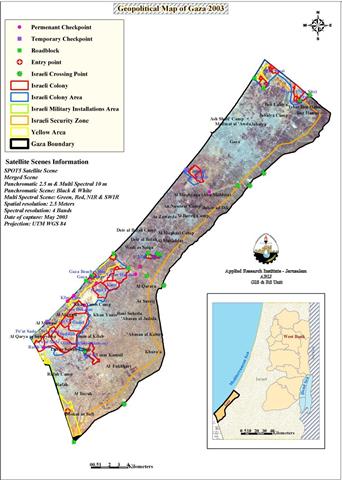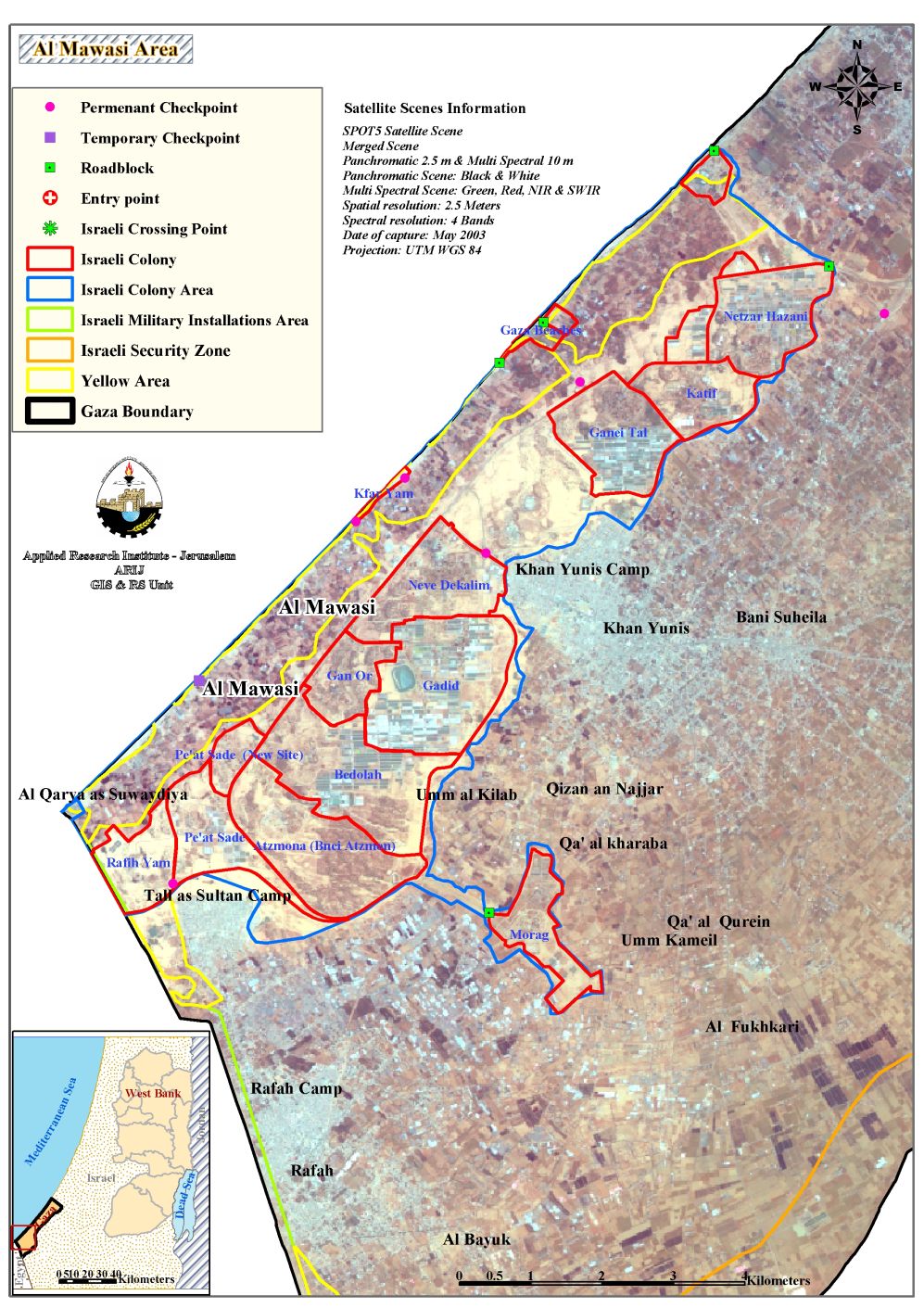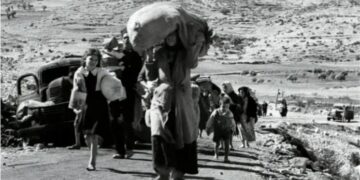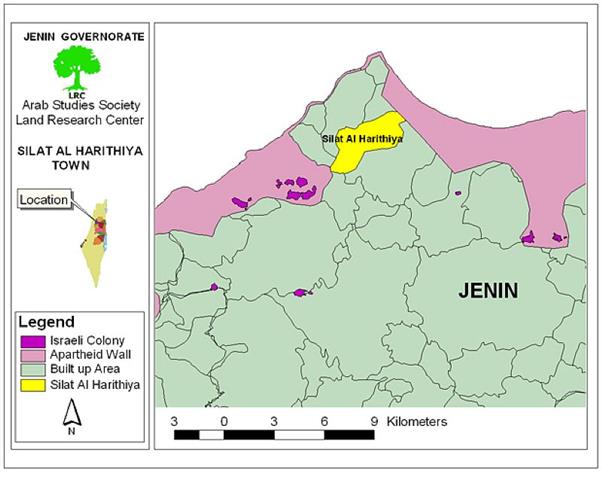Location:
Al-Mawasi is a narrow strip of coastal land located to the southwest of Gaza Strip along the Mediterranean coast from the north of Deir El Balah to the Egyptian border in the south.
Al-Mawasi has two separated areas of administration; Al Mawasi Khan Yunis and Al Mawasi Rafah located to the west of Khan Yunis and Rafah towns. According to Oslo Agreement I which was signed in Cairo on May 4, 1994, and stated the withdrawal from most of Gaza, where the newly formed Palestinian National Authority (PNA) would assume control. The Gaza Strip was delineated by an unbroken line and partitioned into:
1. Those areas which fall under a complete Palestinian control and marked as area A in the West Bank.
2. Those areas (mostly Yellow areas) where authority in security matters is to be shared as in area B in the West Bank, and
3. Those areas where security matters fall entirely within the jurisdiction of Israeli forces as in area C in the West Bank. See Map 1
According to Oslo accords, Al-Mawasi area was classified as yellow areas that are under security Israeli control, but under Palestinian civil jurisdiction and is also considered as the largest Yellow Area within the Gaza Strip. See Map of Al Mawasi
Al-Mawasi is one of the most fertile lands in the Gaza Strip, where agriculture is the main source of income for the Palestinian residents living in the area. Since the beginning of the current Intifada in September 28, 2000, the agricultural productivity has been affected severely due to land razing and destruction of agricultural crops, in addition to the shortage of agricultural equipments. These reasons have contributed directly in the collapse of the agricultural sector in the area.
Population:
There are approximately 4144 Palestinians living in Al-Mawasi, of which 3154 live in Al Mawasi Khan Yunis and the left 990 citizens live in Al Mawasi Rafah. More than 50% of the current populations are refugees who were forced to flee to the area from Israel in 1948 War. (PSBC database 1997)
Settlements expansion:
Today, there are 16 Israeli settlement in Al-Mawasi area, meanwhile Israel continues to illegally expropriate Palestinian lands through various ways, such as land razing, land confiscation and house demolitions, to expand the borders of the existing settlements, in addition to construction of bypass roads. Table 1 shows names of Israeli settlements in Al-Mawasi area.
Table 1: Settlements in Al-Mawasi area
|
No. |
Settlement Name |
Type of settlement |
District |
Date |
|
1. |
Netzar Hazani |
Urban |
Khan Yunis |
1973 |
|
2. |
Gaza Beaches Site |
NA |
Khan Yunis |
NA |
|
3. |
Gaza Beaches |
NA |
Khan Yunis |
NA |
|
4. |
Katif |
Agricultural |
Khan Yunis |
1978 |
|
5. |
Ganei Tal |
NA |
Khan Yunis |
1977 |
|
6. |
Kfar Yam |
Urban |
Khan Yunis |
NA |
|
7. |
Neve Dekalim |
Urban |
Khan Yunis |
1983 |
|
8. |
Gan Or |
Agricultural |
Khan Yunis |
1980 |
|
9. |
Pe'at Sade (New Site) |
NA |
Rafah |
NA |
|
10. |
Bedolah |
cooperative |
Khan Yunis |
1986 |
|
11. |
Pe'at Sade |
Agricultural |
Rafah |
1989 |
|
12. |
Atzmona (Bnei Atzmon) |
NA |
Rafah |
NA |
|
13. |
Rafih Yam |
Urban |
Rafah |
1984 |
|
14. |
Morag |
kibutz |
Khan Yunis |
1972 |
|
15. |
Gadid |
Agricultural |
Khan Yunis |
1982 |
Source: ARIJ database 2001.
The Living conditions of Al-Mawasi citizens:
Palestinians of Al-Mawasi area live in low-level housing conditions where most of their houses are asbestos roofed. Some people also live in small sheds made from plastic or wood. No sewage or water networks are currently available in the area; besides, electricity services are only available for few hours daily. The Palestinian communities are connected by muddy roads that often flood during winter time and consequently become difficult to use.
Violence against Palestinian citizens:
The Israeli activities highly affected the Palestinian lives in Al-Mawasi area; many violent attacks against Palestinian citizens were committed either by settlers living in the nearby settlements or Israeli Occupation Forces. Humiliation, beatings and arrests, as well as other brutality measures such as land confiscation, demolition of houses which continue unabated throughout the years of the current Intifada. Such deliberate incidents of humiliation, physical and verbal abuse are indirect methods of Israel's obligations to ensure the ill humane treatment at all times to Palestinian residents.
The Fourth Geneva Convention is premised on a general prohibition of acts contrary to the principle of humane treatment and various provisions of the Convention also prohibit specific acts against the civilian population 'any measure of such a character as to cause the physical or extermination of protected persons'.
The Israeli Control on Al-Mawasi area:
The Israeli restrictions have grown increasingly against Palestinians since the outbreak of the Second Intifada in 2000, when the Israeli Occupying Forces continued using harsh measures of control which are largely based on restricting the movement of Palestinians entering and exiting the area and moving within the area through special arrangements provided by the Israeli soldiers. So often curfews are imposed by the Israeli Occupation forces (IOF) on Palestinian civilians living in that area.
Al-Mawasi checkpoint is one of the main checkpoints in Gaza Strip which divides the area into three parts: through the Tufakh crossing in Khan Yunis, the Rafah crossing in Rafah, and via the costal Road, which turned the lives of thousands of Palestinian citizens into hell and directly precipitated a humanitarian crisis.
Furthermore the people of Al-Mawasi are forced to bare their chests and pull up their pant legs every time they cross the checkpoint even in the cold weather or during the rainy days. The access through this checkpoint is limited and the checkpoint is only opened for few hours. Most of the times, the checkpoint is closed for several days or weeks at one time; thus denying access to and from Al-Mawasi area.
The opening hours for the checkpoint are from 09.00 -16.00 in winters and 07.00-19.00 in summer. However, conditions of entry as ordered by the Israeli soldiers at the checkpoint are regulated according to age and gender; only men over 40 are allowed to cross the checkpoint on foot, depending on the soldierâ??s mood at that day.
Moreover, restrictions infringe on the right of education. The IOF (Israeli occupation Forces) severely hampered the educational system in Al-Mawasi, primarily by making it impossible for students to reach their schools forcing them to find residency elsewhere, which means they can only return to visit their families sporadically. Restriction on movement in Al-Mawasi have resulted in extensive loss of school days for children, either because of the enforcement of curfews in the area, roadblocks, or teachers were prevented from reaching their schools. Daily, hundreds of Palestinians on there work, schools, hospitals or markets use alternative roads mainly climbing mountains to avoid checkpoints which cause delays to their destinations.
Patients as well face restricted measures which make their access to hospitals in Khan Yunis and Rafah difficult. A considerable number of people died at the checkpoints because of the delays caused by the Israeli soldiers, whereby ambulances are most of the times prevented from crossing the checkpoint to take patients living in the area to hospitals. Sometimes, patients must make their own way over heaps of dirt or be carried on stretchers to the other side of the checkpoint, whereby patients and ambulance crew are detained by the IOF on checkpoints. At other times, patients are threatened to be shot if they do not follow the soldiers' orders. It became difficult for those needing medical assistance to gain permission to exit Al-Mawasi, and even more difficult when entering the area back.
Palestinians are suffering from ill treatment at checkpoints, airports and other parts of the Palestinian territories; as to provide security for the Settlers. But the question is: will the Palestinian people continue to suffer from the Israeli measures under the same pretext?
Related articles:
- The Segregation Wall in Gaza Strip
- A fall from Grace … Al Zahra building towers victims of the Israeli explosives. November 2003.
- Homeless in Rafah, October 2003.
- An analysis on the recent geopolitical situation in the Gaza Strip, September 2003.
- IOF Impair the Gaza Strip, September 2003.
- The Agriculture Sector in Gaza Strip Faces the Fiercest Israeli Attacks During the Intifada
- Al Mawasi Region in Gaza; The Reality of the Israeli War Against Land and Humans
Prepared by:
The Applied Research Institute – Jerusalem
















